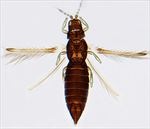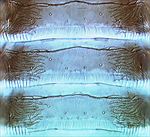
insularis female

insularis pro, meso & metanota

insularis tergites

tongi head & pronotum

fasciatus hind coxae

quadrifasciatus tergites

quadrifasciatus fore wing
Generic diagnosis
Female macropterous. Head wider than long; reticulate and with wrinkles within the reticles; not projecting in front of eyes; ocellar region slightly elevated; occipital ridge absent, cheeks slightly constricted at base; one pair of postocular setae; maxillary palps 2-segmented. Antennae 8-segmented, segment I without paired dorso-apical setae, III with sense cone forked, IV with one forked and one simple sense cone. Pronotum strongly reticulate with wrinkles inside the reticles, no long setae. Mesonotum entire, reticulate with wrinkles, anteromedian campaniform sensilla absent. Metanotum reticulate with some wrinkles, no triangle, median setae behind anterior margin, campaniform sensilla absent. Fore wing anterior margin fringe cilia shorter than costal setae; first vein with wide gap in setal row, two distal setae; second vein with incomplete row of setae; clavus with four veinal but no discal setae; posteromarginal fringe cilia wavy. Prosternal ferna divided; basantra membranous and without setae; mesosternal endofurca without spinula, metasternal endofurca narrowly U-shaped reaching mesothorax. Legs strongly reticulate, tarsi 1-segmented; hind coxae with prominent coiled internal apodeme. Tergites without ctenidia, I–VIII with entire craspedum; tergite II without special sculpture; III–VII reticulate laterally, sometimes with wrinkles in the reticles; VIII without comb; IX without anterior campaniform sensilla; X with median split complete or incomplete. Sternites with entire craspedum; II-VII with three pairs of posteromarginal setae, VII with two small additional setae.
Male similar to female, sternites III–VII with pore plate.
Biological data
A few species in this genus, such as quadrifasciatus, are particularly associated with the leaves of Poaceae, but many live primarily on Fabaceae leaves and these often also occur on many other plants, and sometimes are considered pests of crops. The species that is native to southern China, tongi, is recorded damaging crops of lettuce (Lactuca sativa - Asteraceae) in Japan (Mound & Infante, 2017).
Distribution data
Members of this genus are found throughout the tropics, although one species is found in China as far north as Beijing.
Nomenclatural data
Caliothrips Daniel, 1904: 296. Type species Caliothrips woodworthi Daniel, 1904, by monotypy.
There are 23 species listed in this genus (ThripsWiki, 2020), and the following three species are known from China:
quadrifasciatus (Girault, 1927: 1). (Sericothrips)
insularis (Hood, 1928: 234). (Hercothrips)
tongi Mound, Zhang & Bei, 2011: 58.
Relationship data
Thripidae sub-family Panchaetothripinae: this group is represented widely around the world, particularly in tropical areas, and comprises about 40 genera. Although Caliothrips was placed in a separate family by Bhatti (2006), primarily because of the remarkable autapomorphic apodeme within the hind coxae, relationships of this genus seem to be within the Panchaetothripinae (Mound et al., 2001). Mirab-balou et al. (2011) recorded four species of this genus from China. However, the records of the Californian species, fasciatus (Pergande), are now considered misidentifications of the native species, tongi. Moreover, the record of indicus (Bagnall) from Guangdong is apparently a misidentification of the grass-living species, quadrifasciatus (Girault). Relationships among species within this genus were discussed by Mound & Infante (2017).
References
Bhatti JS (2006) The classification of Terebrantia (Insecta) into families. Oriental Insects 40: 339–375.
Mirab-balou M, Tong XL, Feng JN & Chen XX (2011) Thrips (Insecta: Thysanoptera) of China. CheckList 7 (6): 720–744.
Mound LA & Infante F (2017) Relationships among Caliothrips species (Thysanoptera: Panchaetothripinae) with one new species from Mexico. Zootaxa 4291 (2): 384–390.
ThripsWiki (2020) ThripsWiki - providing information on the World's thrips. <http://thrips.info/wiki/Main_Page>